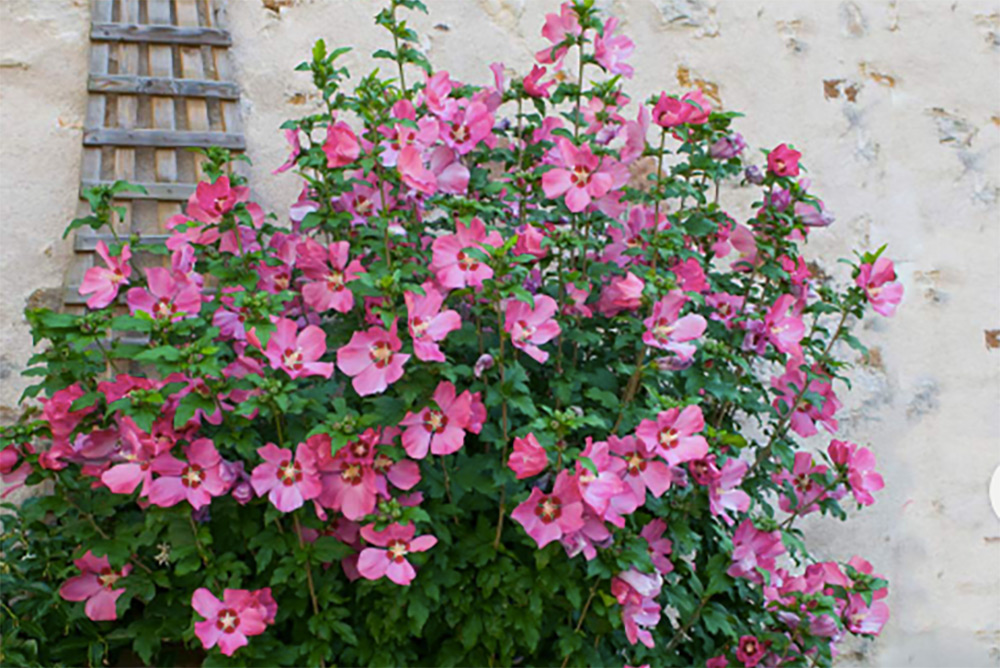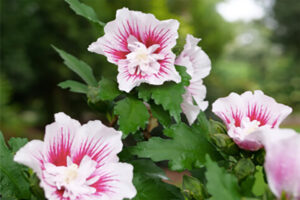By Stephanie Cavanaugh
SEVERAL DECADES ago, Baby and The Prince bought me a Rose of Sharon (Hibiscus syriacus) for Mother’s Day.* I gritted my teeth, smiled, and thanked them. Though it was jolly enough with its white flowers and a splotch of red at the center, it brought to mind old ladies, aprons, fuzzy scuffs, and kitchen wallpaper with tea kettles and cats.
We planted it alongside the back porch.
Eventually, I began to like it. I can be slow, so it took some years for me to notice that the flowers were related to and resemble the tropical hibiscus, which should have been apparent given my plant’s Latin name. I’m a tropical sort of person, so of course it should suit me. What was I thinking?
It didn’t take long for it to become a tree, topping the porch fence, a good 15 feet above the ground. It’s now visible from the second floor, a froth of red and white that sets a jaunty mood for outdoor dining.
If it weren’t for these plants, I’d have virtually no color in the back garden.
As it grew, the tree threw off seedlings that somehow populated turf many yards away. We yanked some and planted others: one in another backyard border, several in the alley behind the garage, a few in the front beds alongside the sidewalk. Baby snagged some for her garden. Most of the seedlings came up purple, a mutation that just happens.
All grew tall and branched out, flowering in full sun or part shade, with virtually no water besides the rain from early summer through fall and virtually disease free. Perfect plants for the lazy and the sun-challenged.
We viewed the plants as free filler.
Unfortunately, and this must be said, since if I don’t some plant person will give me a lecture: Most varieties of Hibiscus syriacus are considered invasive, a particular nuisance in Kentucky, Pennsylvania, Tennessee, and Virginia. The plants can escape whatever confines you’ve confined them to, and crowd out more desirable plants while they’re at it. This led to the Rose of Sharon being named as the Weed of the Week by the USDA Forest Service in July 2005. Not sure which week—sorry, July was the best I could do.
BUT! There are several varieties that have been cultivated not to mount invasions. The National Arboretum introduced several varieties that are considered sterile: Diana (white), Aphrodite (pink), Minerva (pale lavender), and Helena (white with a red eye). And there’s Sugar Tip, another pink that produces no seed.
Then there’s Pink Chiffon and Starburst Chiffon, which sound like dueling RuPaul contestants or Eddie Murphy characters. But the first is a divine light pink and the second is white with red and pink centers—both are big and fluffy and as ruffled as a Galliano ball gown. They’re also said to have a longer season, leafing out and flowering in early spring and lasting well into the fall.
No matter the variety, the branches of the Rose of Sharon are laden with flowers throughout the season, attracting bees and butterflies. Come those sweaty dog days of August, only the crape myrtle can compete with such color and bounty.
*As Mother’s Day approaches, one (that would be me) hopes someone is reading this.



I had three volunteer in my garden, and pulled hundreds of seedlings underneath them year after year until a native plant expert told me they are invasive. (Should’ve guessed!) I had them removed. Now that I know, I see them all over the neighborhood. ROS easily escape our cultivated gardens and invade wild areas, displacing native plants that are essential for insects, pollinators, birds, and wildlife to survive. See link for more info & native alternatives that support biodiversity and a balanced ecosystem: https://mgnv.org/plants/invasive-plants/rose-of-sharon/
Some of the problems Rose of Sharon cause include:
Escapes from cultivation to colonize in natural
areas, crowding out and displacing native plants
Produces numerous seed pods, which are spread by wind
Very difficult to remove because of strong, deep tap root
Even tiny volunteer seedlings are woody and difficult to remove
Hi there: Stephanie responded to your comment:
Ah! There you are! You chided me last week about my choice of ground covers. But this time, please reread paragraph eight. There are several varieties of this plant, including some blessed by the National Arboretum (and if you can’t trust them, well…) that are NOT invasive. Just lovely. I appreciate your advocacy and the careful attention you pay—they make my day.